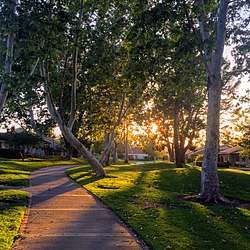University Park, Irvine, California
University Park is a village in the southern portion of the city of Irvine, Orange County, California near the University of California, Irvine and Concordia University, Irvine. The area was developed as Irvine's first master-planned community village and contains single-family detached and attached, town-home, and apartment communities in the California Modern architectural style. It is bounded by University Drive to the south, Culver Drive to the west, and the San Diego (I-405) Freeway to the north. The village celebrated its 50th birthday in July 2016[1].
History
University Park was built in phases beginning in 1965 shortly after plans for a nearby University of California campus were announced. The village, whose opening predates Irvine's city-hood by five years[2], was envisioned to attract buyers from a wide range of demographics and was designed to offer various housing types to meet the diverse needs of its target residents[3]. Designed in collaboration with Peter Walker, Dick Law, and Kalvin Platt of Sasaki, Walker and Associates, the village utilized the Garden City approach to planning by designing clusters of homes to face publicly-accessible park areas and greenbelts tucked away from principal roadways[4]. These greenbelts were also designed to link neighborhoods and amenities in the village, including schools, shopping centers, the library, and recreation areas. At the time of its construction, the village's planning concepts were considered experimental, and home sales were slow because of the village's isolation from other built-up areas and because the nearby I-405 freeway was still under construction[5]. However, upon its eventual completion, the village contained Irvine's first library, high school, and retail shopping center.
Innovations in planning and design

Designed and constructed with Garden City urban planning concepts, University Park contains several notable attributes that distinguish it from other contemporaneously-built communities. These attributes include:
- The use of zero-lot line construction to jointly maximize developable and open space areas, minimizing the resources required to maintain private lawns on each lot[6]. This method of site planning and construction results in larger common open space areas that are maintained by the homeowner associations in the village and that can be used by all residents and visitors.
- Development of a master-planned community with a variety of housing types to attract a wide range of demographics. While many other tracts under construction at the time contained a single product type, such as all single-family homes, University Park was designed and built to contain single-family detached homes, single-family attached homes, town-homes, and apartments. This range of product types was deliberately selected to attract buyers to complement the needs of the faculty and families of the nearby University of California, Irvine under construction at the time.
- Linking community amenities with the use of greenbelts and bikeways separated from main roadways. William Pereira, Master Plan designer for the Irvine Company, wished to create a village with lower dependence on automobiles. Today, pedestrians and cyclists can reach nearly all of University Park's community amenities and shopping centers without having to share a roadway with motor vehicles.
- Inversion and reinvention of the cul-de-sac. In University Park, nearly all cul-de-sacs are rectangular in shape. Early village designers recognized that the traditional, round cul-de-sac presented parking difficulties and contained too much asphalt without a central focal point. By reshaping the cul-de-sac into a rectangle, planners were able to place community-oriented areas, such as playgrounds or green spaces, in the middle of the rectangle and surround it with street parking for the residents of that block[7]. This design also reduced the need for each home on the block to have a two-car driveway, further maximizing the amount of developable land for open space and building.
Amenities, facilities, and neighborhoods
University Park comprises multiple neighborhoods and associations[8] and contains a high concentration of community facilities and amenities. In addition to its greenbelts and bikeways, the village contains community facilities, parks, schools, religious institutions, a library, commercial centers, adjacency to open space and recreational areas, and access to transportation.
Neighborhoods and associations
- University Community Association
- The Terrace Community Association
- Parkside Community Association
- Parkcrest Community Association
- Village Park Community Association
- Parkwood Apartment Homes
Schools and library
- Rancho San Joaquin Middle School
- University Park Elementary
- Village Montessori
- University Park Library (a branch of Orange County Public Libraries system)
Parks and open space and recreational facilities
- University Community Park
- Adventure Playground
- Dave Robins Park (private)
- Quail Hill Preserve (access from Shady Canyon Drive in the Quail Hill neighborhood)
- Sand Canyon Wash
- Tanaka Farms
- Strawberry Farms Golf Course
- William R. Mason Regional Park (access from University Drive in the Rancho San Joaquin neighborhood)
Religious institutions
- Light of Christ Lutheran Church
- University United Methodist Church
Commercial centers
- University Park Center
- Parkview Center
Transportation
- Orange County Transportation Authority (OCTA) bus routes
- San Diego (I-405) Freeway
- San Joaquin Hills (SR-73) Transportation Corridor (2.1 miles west via University Drive)
- John Wayne Airport (2.3 miles west via Michelson Drive)
References
- "Irvine's University Park throws a party to celebrate half a century". Los Angeles Times. 2016-07-30. ISSN 0458-3035. Retrieved 2018-01-11.
- Chan, Alex (2016-07-29). "University Park, Irvine's first 'village,' celebrates 50 years". Los Angeles Times. ISSN 0458-3035. Retrieved 2018-01-11.
- Company, Irvine. "A Place Called Home: University Park Was The First Expression Of Irvine's Master-Plan Concept - The Irvine Company - 150th Anniversary". Celebrating 150 Years - The Irvine Company 150th Anniversary. Retrieved 2018-01-11.
- "University Park - Irvine | The Cultural Landscape Foundation". tclf.org. Retrieved 2018-01-11.
- "Throwback Thursday: It took a village, or several, to build Irvine". Orange County Register. 2015-03-05. Retrieved 2018-01-11.
- Hess, Alan (2014-10-27). "Discovering Irvine". Places Journal (2014). doi:10.22269/141027.
- "David Whiting: Celebrating 50 years after Irvine's first village". Orange County Register. 2016-07-25. Retrieved 2018-01-11.
- "Irvine Homeowners' Associations". City of Irvine. 2015-06-13. Retrieved 2018-01-11.